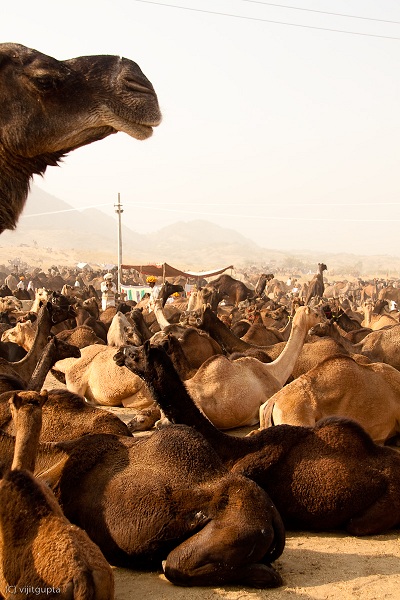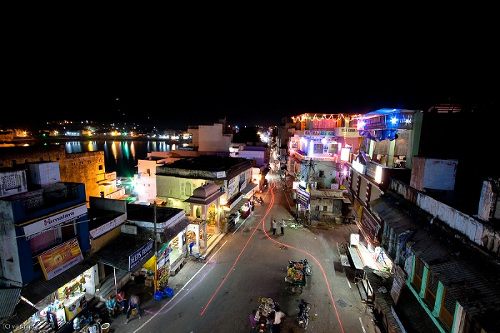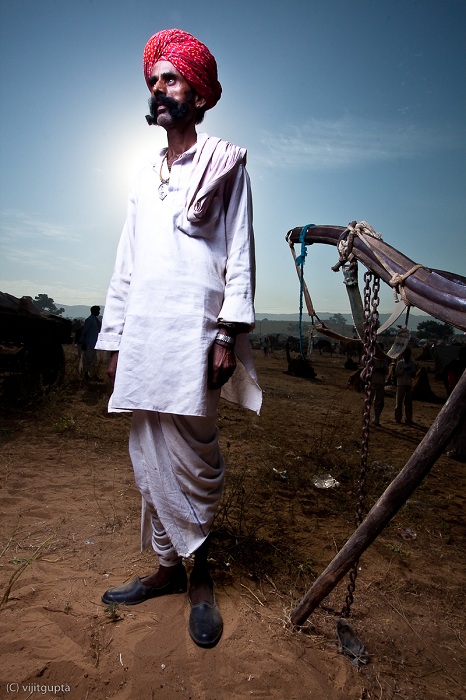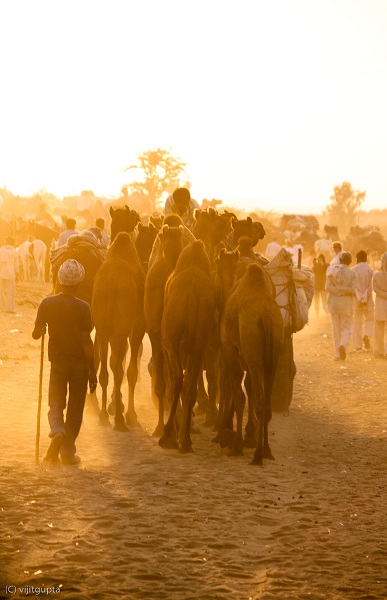|
by Vineet Kaul, photography by Vijit Gupta

Somewhere, far from the hustle and scurry of our metro existence, there are nuggets of land where the breezes are cool, the silence is still, the sunlight glistening on lakes is perfect and where the little gadgets that connect us to the world but distract us from ourselves are optional. In an attempt to dodge the city's parade of ear-splitting cracka-lacket noise and air pollution, I and the photographer Vijit Gupta ventured out seeking the solace of placelessness. Now that may not be a word, yet, but the feeling it attempts to express is celestial; one that can be roughly translated as a "me-shaped place." We took to the open road armed with an endless appetite for desi-ghee dal-bati and an inkling to head northwards: the idea was simple, the budget was moderate and the equipment was a cruiser bike, a writing pad, backpacks and a camera. The place we picked is a city home to one of the only temples to Lord Brahma, over 50 ghats and nearly four hundred temples located by a lake. If the destination is still ambiguous, then you have only two options: jog your memory through high school history classes (and I hope all the photographs of camels will help) or wait for me to spell it out—Pushkar. About 13 km from Ajmer in Rajasthan, the Pushkar Camel Mela (fair) is held every year in October-November in the run up to holy day of Kartik Purnima. Now for the privileged traveller the ideal thing to do would be to catch a flight to Jaipur and make the three-hour drive by cab. Or you could take a hot air balloon ride and get an aerial view of the proceedings, before you resort to the plush lodgings of Dia or Greenhouse. We, however, wanted the dirt and tan of the highway. We wanted to get lost in the crowd, and not just see the magic but be in the magic. We wanted to step on things, the scent of which would linger in our tent for nights to come. Cattle-trading, folk music, Rajasthani dance and an itinerary to explore as much as we could in five days, we tanked up and ploughed the desert with mid-twenties' wanderlust. 
The experience can be quite baffling, especially when you reach the mela just in time to find out that the opener is a camel race and the first local you talk to claims to have walked from a village 60 km away to participate in the "best moustache" competition. From there, the weird only gets weirder. Next follows musical chairs played on camelback, and then a camel beauty pageant where the "ships of the desert" follow orders from their masters in a manner that would put most house pets to shame. The craziest of events, by far, is the ladoo oonth where men pile on camels' backs and the animal that can lift the most weight/men is declared winner. Needless to say a lot of human-camelback pyramids taste sand and donate their teeth to the ground as souvenirs. So far away from the metropolis, it can be hard to make out the men from the animals. 
Pushkar Lake, too, can be quite perplexing if you don't understand the mythological anatomy of the frenzy that crowds its 52 bathing ghats. I originally assumed that people from the desert were just happy they had a chance to bathe. But 8 km later, we found out that according to scripture the lake was formed from petals that fell from the hands of Lord Brahma himself and it is thus the Tirthraj (the holiest of tirths). One dip in Pushkar Lake on Kartik Purnima corresponds to hundreds of years of performing yajnas. Each of the small ponds, kund, based near a ghat is also said to grant special powers. The four we heard about from a local tea-stall owner could have granted fertility, wisdom, charisma and cured leprosy. Not being fond of bathing and assuming we possessed the first three and didn't have the fourth, we wasted no regret on not taking a dip. Our trip was short, and we weren't going to hang around till the 10th for Kartik Purnima anyway. Winding up our act before the main event, we waved a general goodbye to the approximately three lac tourists and 20,000 camels that statistics reported each year. The confederacy of people and animals was unforgettable, and the hangover from all the colours was probably why the highway, during the ride back, appeared black and white. We spent a lot of time arguing whether the lack of toilets was intentional, an argument which I eventually won with a snide observation that maybe out of the vainest of vain hopes people wanted to fertilise the desert soil. It may be farfetched, but I can't help but call the desert mela trip a cruise in a sea of sand, colour and cattle. I should probably add temples to that list, since there were enough of them to make an agnostic reconsider his views. It all goes to show that the camel fair has far more to it than camels. Like Westerners, for example. Some hotels even have wall clocks showing Israeli time. In certain locales, I couldn't tell if we were at a Western event popular with rural Rajasthani visitors or vice versa. Either way, the state tourism board rightly warned you about the burst of colours. I recommend the glares. And bottled water, of course. In the madness of the mela and the crowds, we two wayfarers found a oneness in which being still made as much sense as moving along. A "me-shaped" place, like I said earlier. While Vijit kept squinting and hiding behind his camera lens, I kept scratching my head while trying to maintain my wide-eyed stare, take notes and find the right word to capture it all. We savoured the carnival for its urine soaked corners, its overwhelming spurts of ethnicity, noise and smoke and its kiosks with prices directly proportional to the colour of your skin. We felt neither connected to the flock of foreign tourists nor a sense of belonging with the locals—a perfect premise to contemplate who we are. Placelessness accomplished. 
|